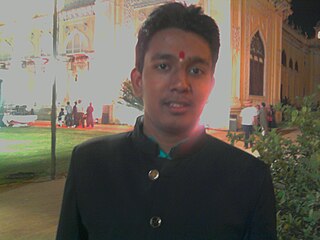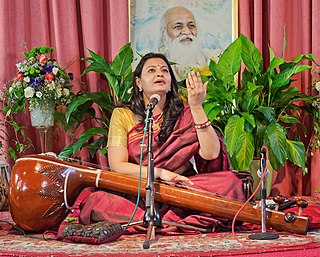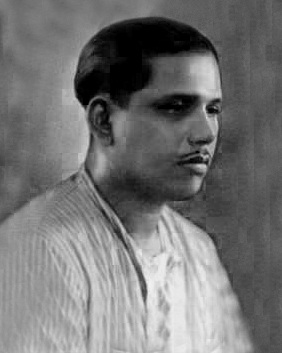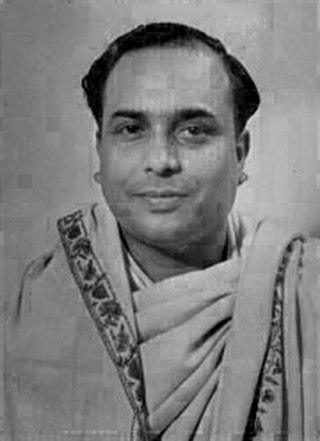Related Research Articles
Hindustani classical music is the classical music of northern regions of the Indian subcontinent. It may also be called North Indian classical music or, in Hindustani, shastriya sangeet. The term shastriya sangeet literally means classical music, and can also mean Indian classical music in general. It is played on instruments like the veena, sitar and sarod. Its origins from the 12th century CE, when it diverged from Carnatic music, the classical tradition in South India. While Carnatic music largely uses compositions produced in Dravidian languages and Sanskrit, Hindustani music largely uses compositions written in Punjabi, Rajasthani, Urdu, and Braj Bhasha.
In Hindustani music, a gharānā is a system of social organisation in the Indian subcontinent, linking musicians or dancers by lineage or apprenticeship, and more importantly by adherence to a particular musical style.

The Mewati gharana is a musical apprenticeship tribe of Hindustani classical music. Known for being Pandit Jasraj's musical lineage, the gharana was founded by brothers Utd. Ghagge Nazir Khan and Utd. Wahid Khan (beenkar) of Indore in the late 19th century at the Holkar Court. Members of this gharana have had an active influence in Indian cinema for over half a century.

Ganesh Balawant Nawathe, better known as Pandit Jitendra Abhisheki, was an Indian vocalist, composer and scholar of Indian classical, semi-classical, and devotional music. While he distinguished himself in Hindustani music, he is also credited for the revival of the Marathi musical theatre in the 1960s. Jitendra Abhisheki has been praised as being "among the stalwarts of Hindustani classical music who mastered other musical forms such as thumri, tappa, bhajan, and bhavgeet. His work in Marathi natyasangeet is well-known."
Pandit Budhaditya Mukherjee is an Indian classical sitar and surbahar maestro of the Imdadkhani gharana (school), recognizable by his intricate vocalic playing complemented by spectacular high speed playing. He holds a unique distinction of being the ever first artist in history to perform in the House of Commons, London. Famously proclaimed the "sitar artist of the century" by veena great Balachander, he has performed in thousands of concerts since the 1970s in India, America, Australia, the UAE, and almost all of Europe.
The Agra gharana is a tradition of Hindustani classical vocal music descended from the Nauhar Bani. So far, Nauhar Bani has been traced back to around 1300 AD, during the reign of Emperor Allauddin Khilji of Delhi.
The Gwalior Gharana is one of the oldest Khyal Gharana in Indian classical music. The rise of the Gwalior Gharana started with the reign of the Mughal emperor Akbar (1542–1605).
Arnab Chakrabarty is a Hindustani classical musician and sarod player based in Toronto, Canada.

Baba Bhaskar Nath is an Indian classical instrumentalist. He plays the Shehnai belonging to Meerut Shehnai Gharana. He is a child prodigy.

Swara Samrat festival is a four-day annual festival of Indian classical music and dance held during the winters in Kolkata, India. This festival is the brainchild of Sarod maestro Pandit Tejendra Narayan Majumdar, his vocalist wife, Manasi Majumder and their Sarod player-son Indrayuddh Majumder. The festival is dedicated to Swara Samrat Ustad Ali Akbar Khan. Indian Classical Music and Dance Legends such as Pandit Shivkumar Sharma, Pandit Birju Maharaj, Pandit Hari Prasad Chaurasia, Pandit Jasraj, Ustad Zakir Hussain, Ustad Aashish Khan, Dr. Girija Devi, Begum Parveen Sultana, Pandit Swapan Chaudhuri, Guru Karaikudi Mani, Ustad Rashid Khan, Shankar Mahadevan, Pandit Budhaditya Mukherjee, Pandit Ulhas Kashalkar, Pandit Venkatesh Kumar, Pandit Ajoy Chakraborty, Pandit Anindo Chatterjee, Pandit Sanjay Mukherjee, Ustad Shahid Parvez, Ustad Shujaat Khan, Pandit Tejendra Narayan Majumdar, Pandit Kushal Das, Pandit Rajendra Gangani, Guru Sujata Mohapatra, Pandit Subhankar Banerjee, Pandit Yogesh Samsi, Pandit Bickram Ghosh, Pandit Tanmoy Bose and Kaushiki Chakraborty are some of the artists who have previously performed in this festival.

Sudhir Nayak is an Indian classical Harmonium player, a disciple of Pandit Tulsidas Borkar and Pandit Jitendra Abhisheki. Sudhir has the honour of having performed along with Pandit Bhimsen Joshi and Shubha Mudgal at the Central Hall of the Parliament of India
Ustad Bade Inayat Hussain Khan (1837–1923) was a classical Indian vocalist who belonged to the famous Gwalior Gharana. He was the son of Haddu Khan who was the maternal grandson of Nathan Pir Bakhsh, the founder of Gwalior Gharana. He was the first person to introduce Bol Bant in Khayal Gayki. His Khayal Gayki is used in all the Gharanas. Haddu Khan's son Bade Inayat Hussain Khan (1852–1922) was a singer who expanded the Gwalior style from the methodical form it followed to the emotional style that he preferred.

Dr. Meeta Pandit is a Hindustani Classical vocalist and a leading exponent of the Gwalior Gharana. She is the granddaughter and disciple of Krishnarao Shankar Pandit and daughter of Laxman Krishnarao Pandit. She is the sixth in the unbroken lineage and the first woman in the family to have taken up music as a profession.
Gaan Maharishi Pt. Krishnarao Shankar Pandit (1893–1989) was an Indian musician, considered by many as one of the leading vocalists of the Gwalior gharana. He authored several articles and 8 books on music and was the founder of Shankar Gandharva Mahavidyalaya, a music college based in Gwalior. The Government of India awarded him the third highest civilian honour of the Padma Bhushan, in 1973, for his contributions to music. He was also a recipient of several other honors, including the 1959 Sangeet Natak Akademi Award and the 1980 Tansen Award of the Government of Madhya Pradesh.

Gauri Pathare is an Indian musician and a winner of the All India Radio competition.

Shashwati Mandal is a Hindustani classical music vocalist. She is an exponent of the Gwalior gharana.

Vishmadev Chattopadhyay was an eminent vocal artist in Indian Classical Music, a revered Guru in the Delhi Gharana of the vocal classical genre, and a music director in Bengali Film Industry in its early era.
Ramkumar Chattopadhyay was an eminent Bengali singer, composer and music director. He was well known as a classical singer with a unique repertoire of Puratani songs, devotional songs and Tappa.

Acharya Chinmoy Lahiri was an Indian vocalist from Bengal in the Hindustani classical tradition. He is known for the Khayal form of singing, as well as for his popular renditions of Dhrupad, Thumri and Tappa, along with Bengali Raga-pradhan songs.
Nazir Khan, more commonly known as "Ghagge" Nazir Khan or Jodhpurwale Nazir Khan, was an Indian classical singer and, along with his elder brother Wahid Khan, founded the Mewati gharana, later popularized by Pandit Jasraj.
References
- ↑ "Types of Music Compositions: Tappa". 8 August 2012.
- ↑ Massey, R.; Massey, J. (1996). The Music of India. Abhinav Publications. p. 55. ISBN 9788170173328 . Retrieved November 17, 2014.
- ↑ Meeta Pandit
- ↑ Pandit, Meeta. "Sitarist Adnan Khan spells magic on stage". The Tribune. No. 15 October 2016. The Tribune, Chandigarh.
- ↑ "Tapping tappas". The Hindu . Jan 16, 2006. Archived from the original on October 9, 2013. Retrieved May 29, 2013.
- ↑ Archived at Ghostarchive and the Wayback Machine : "Pt. Shekhar Borkar - Tappa on the Sarod". YouTube .
- ↑ "Shekhar Borkar". Archived from the original on 2014-04-05. Retrieved 2014-04-05.
